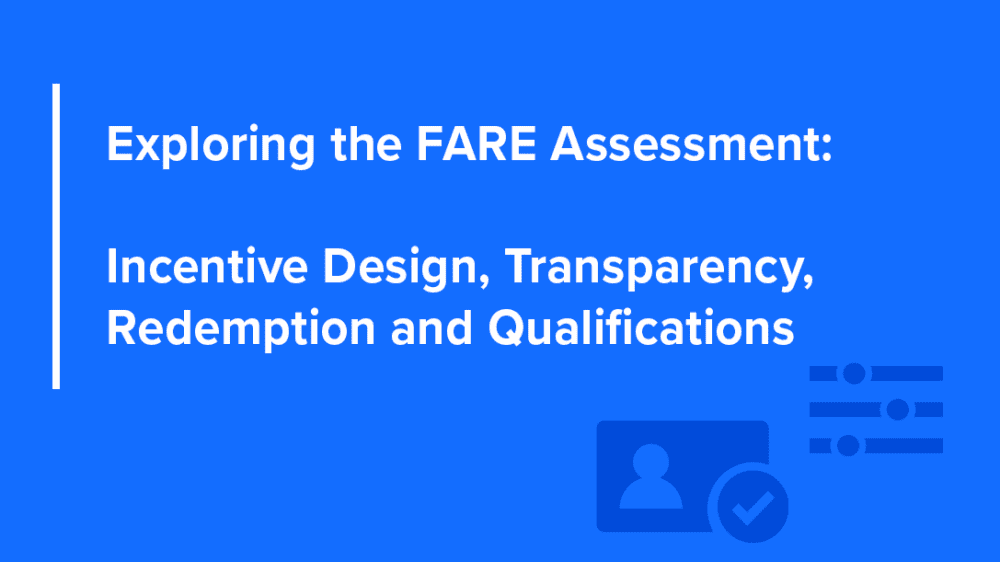The research participant experience has reached a breaking point.
Participants spend precious time answering a survey, only to feel like just another data point—ignored, undervalued, and quickly forgotten. This is the harsh reality for millions of participants who’ve been trapped in a system that prioritizes speed over substance.
“We have to understand people and society first, then build our research methods around that understanding,” says Frank Kelly, Market Research Practice Lead at Virtual Incentives.
This participant-first approach creates research experiences that work better for everyone involved.
The FARE Framework includes twelve areas for evaluating participant experience. Four of these elements—ease of redemption, transparency and communication, effort to qualify, and research design—are often overlooked yet crucial for building strong relationships with participants. Poor attention to these elements leads to frustrated respondents and compromised data quality.
Let’s examine how these four components work together to create better research experiences and improve data quality.
Create a participant experience built on easy rewards
Many companies make it needlessly difficult for participants to claim their research rewards. Some do this on purpose to save money by reducing how many people redeem their incentives. This strategy backfires by creating a negative participant experience and pushing away quality respondents.
Consider one participant’s experience with an airline voucher reward. After being bumped from a flight, they received a substantial $500 credit. However, redeeming it required an hour of work, multiple phone calls to customer service, and tracking down an old reservation number that had since changed. The process was clearly designed to discourage redemption.
Similar issues plague research rewards. Many companies still rely on sweepstakes instead of guaranteed payment or make participants wait weeks for rewards when instant delivery is possible. Some gift cards come with arbitrary restrictions—like being limited to online use only. This posed a problem for one participant who received a $50 Best Buy gift card. They couldn’t use it in the store, making the reward far less valuable since they rarely shop online.
Luckily, modern payment technology offers better solutions. Digital wallet integration lets participants add their rewards to Apple Pay or Google Pay for convenient tap-to-pay purchases. Tokenized payment systems allow both online and in-store use. Companies can deliver rewards instantly through multiple channels, from direct bank deposits to virtual cards, matching participant preferences.
Build trust through transparency
Transparency in research is about more than just sharing basic information. It’s about helping participants understand exactly what they’re getting into. Many research activities appear simple at first glance but often involve significantly more work than participants initially realize.
True transparency means being upfront about all research project requirements. This includes clearly communicating what information will be collected, potentially sensitive details like personal data such as date of birth or social security number, and the expected workload. Participants should receive enough information to be able to make an informed decision about whether they want to participate.
With research becoming increasingly technology-enabled, participants also need to know upfront about potential technical implications. For instance, will the study require using a webcam? Might an app impact phone battery or performance? These details should be clearly communicated before participants commit.
Communication itself requires a delicate balance. There can be too little information, but also too much. The goal is to find the right level of communication that conveys pertinent information without overwhelming participants. Importantly, companies should strive to be honest and upfront about everything involved in the research.
Improve the participant qualification experience
Ten years ago, about 40% of people who tried to qualify for a survey were accepted. Now, that number has dropped to just 15%. This means participants are spending significantly more time attempting to qualify than actually completing research activities.
Companies often use lengthy screening processes that waste participants’ time. Many surveys ask 15 or more questions about irrelevant details like marital status, pet ownership, or other personal characteristics before getting to the key qualifying question. Participants might spend several minutes answering these background questions, only to be excluded from the survey.
A better approach starts with smart profiling. Maintain detailed participant profiles about relevant topics—from healthcare experiences to automotive preferences to professional decision-making roles. By compensating people fairly for completing these profiles and using the data strategically, companies can target the right participants for each study while reducing qualification time.
Modernize research design
Technology has changed how people interact, but many research approaches remain stuck in the past. Researchers often impose their own views and predetermined answer choices, which may not accurately reflect participant experiences or perspectives.
The future of research design requires a more nuanced approach. Researchers should consider using more open-ended questions to allow participants to share their genuine thoughts, rather than forcing them into pre-selected answer categories. By asking open-ended questions first, researchers can discover answer choices they might not have originally considered. AI technologies can now help analyze these open-ended responses efficiently, making it easier to process qualitative data across multiple languages and contexts.
A recent project revealed that companies often get 90% of their valuable insights from just 40% of their data collection efforts. The remaining 60% of data collection creates unnecessary work for participants without serving any meaningful business purpose. This highlights the need to design more focused and efficient research methods that respect participants’ time and generate genuinely useful insights.
Moving toward better participant experiences
Major changes are reshaping research as AI advances and participants expect better experiences. Companies need methods that respect people’s time and provide real value for their help.
The FARE framework gives companies a structured way to evaluate and improve every aspect of the participant experience. When organizations carefully consider reward redemption, offer transparency and clear communication, streamline qualification, and modernize their research design, they create experiences that benefit everyone involved.
Companies that make these improvements see higher response rates, better quality data, and stronger participant relationships. By putting participant needs first and embracing new methods, research organizations can build a stronger foundation for future success.
